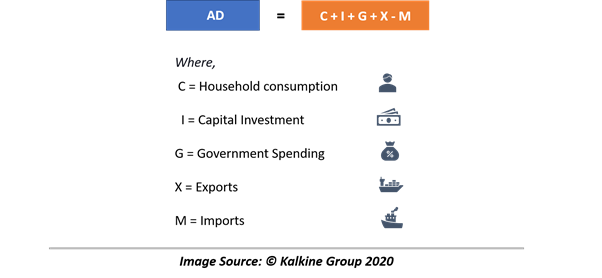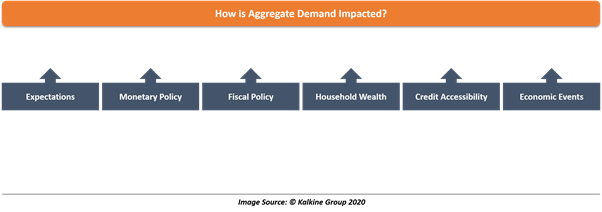What is Aggregate Demand?
Aggregate Demand (AD) is a macroeconomic term primarily used in the computation of national income through Aggregate Demand - Aggregate Supply Model.
It is a nation’s demand for goods and services by businesses and households along with the demand from foreign countries for the nation’s goods and services. Aggregate demand excludes demand of businesses and households for foreign resources.
It essentially is the amount of money spent by households on goods and services, plus spending on capital investment, plus government spending, minus net exports. This gives the below equation for aggregate demand.

Moreover, aggregate demand is a function of household consumption, capital investment, public spending, and net exports.
What is Consumption?
It is the expenditure by the households of an economy on goods and services. Consumption means the amount of money spent by households on buying non-durable goods, durable goods, and services in a given period.
The essence of the spending is that it should be consumed or re-purchased by the households of an economy. As an aggregate measure for the whole economy, it basically represents the capability and intention of households to consume in the given economic environment.
What is Capital Investment?
Capital investment refers to the total spending in a country on capital goods, which are kind of durable goods used as a factor of production. It essentially refers to the amount of fresh investment being made in the country.
Capita investment also includes the amount of money spent on working capital, which consist of finished goods, work-in-progress, raw material etc. Further, investments can be undertaken by the state as well as the private sector.
Infrastructure spending is an example of a state’s capital investment, so is building new colleges, schools, hospitals, etc. Despite a major component of aggregate demand, capital investment has significant supply-side impacts on the economy.
Change in the value of stocks also constitutes a part of an investment. When demand is running higher than output, stocks will decrease. Likewise, stocks will increase in a case when demand is weaker than expected output.
What is Public Spending?
Government spending is an effective tool in times when the crisis is deep into the economy, and spending by state eventually adds to the aggregate demand. How the Government intends to spend depending on the political narratives of the incumbent Government.
Although state spending is also included in capital investments, public spending here refers to the subsidies and welfare payments to the people of the nation, especially the ones who are vulnerable.
During a crisis, the intensity of Government spending increases. But in a normal course, the spending levels by the state on subsidies will remain marginal.
What is Net export?
It means the aggregate exports minus imports during a given period. When net exports are positive, it indicates that there is a trade surplus, adding to the aggregate demand. Negative net exports mean trade deficit and lower aggregate demand.
How is aggregate demand impacted?

Expectations
Household spending could be impacted by the level of income and inflation in the economy. A falling income level means, households would be more inclined to save rather than to spend. Consumption of households is also impacted by the changes in the price level because rising prices makes goods and services costlier.
Also, the expected changes in income and inflation also impact the investment by businesses since demand is believed to be lower as consumption goes down.
Monetary policy
Interest rates impact both households as well as businesses. When interest costs are lower households are more inclined to consume, and businesses try to invest at a lower cost of the capital. Interest rates in the economy impact the consumption and investment of a nation.
Fiscal policy
The changes in fiscal policy also impact aggregate demand. This can be in the form of Government spending, taxation and borrowings. When income taxes are lowered by the state, it means that consumption would improve since disposable income rises. Likewise, investment capability would increase for businesses when income taxes are lowered.
When the Government is spending heavily in the economy by building roads, hospital, school, etc., the direct impact would be on the aggregate demand.
Household wealth
Household wealth impacts the confidence among households in the country. Rising property prices, shares prices also means that some households with asset classes are increasing their wealth, which gives them the confidence to spend more.
Similarly, when asset prices fall, the confidence among the households fall as the wealth of the people is also on a fall.
Credit accessibility
Lower interest rates do not necessarily mean the credit would be available to each section of society. People with vulnerable credit history may not be able to get credit even though interest rates are lower.
Policymakers have now started to emphasise on the credit supply in the economy. And this applies to households as well as businesses of the economy, thus impacts consumption and investment in the economy.
Economic events
Currency movements also have a considerable impact on the aggregate demand levels of a country. Depreciation in the currency makes the exports cheaper and imports costlier, thus improving trade position.
Falling demand and consumption in a large export would also mean that the demand for exports would also hit lower levels. Similarly, tariffs and duties by the destination, where exports are scheduled, would increase the cost of imports for those people, thus hurting exports.
 Please wait processing your request...
Please wait processing your request...